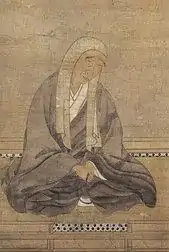Shōkū
Shōkū (証空, November 30, 1177 – December 24, 1247), sometimes called Seizan (西山), was a disciple of Hōnen, founder of the Jōdo-shū Buddhist sect. Shōkū later succeeded Jōhen, another disciple of Hōnen, as the head of a former Shingon Buddhist temple, Eikandō, established a separate branch of Jōdo-shū called the Seizan branch (after its namesake), and completed the transition of Eikandō from a Shingon temple into a Jōdo shū one.
Shōkū (証空) | |
|---|---|
 Undated portrait of Shoku | |
| Title | Founder of Seizan branch of Jōdo-shū Buddhism |
| Other names | Seizan (西山) |
| Personal | |
| Born | November 30, 1177 |
| Died | December 24, 1247 |
| Religion | Buddhism |
| School | Jōdo-shū Buddhism, Seizan Branch |
| Other names | Seizan (西山) |
| Senior posting | |
| Teacher | Hōnen |
Biography
According to the temple's biography, Shōkū was born into a noble family, but by 14 years of age took an interest in Buddhism. In one legend, his mother stood before a famous bridge to have his fortune told. At that time, a monk passed by chanting the Lotus Sutra, which convinced her that he should be a priest.[1] It was then that Shōkū studied under Hōnen for 23 years. Later in life, he became a disciple of Jōhen, who had recently converted from the Shingon faith to the Jōdo-shū faith, subsequently converting the Eikan-dō as well. Later Shoku took over as head of this temple, and fully converted the temple into a Jōdo shū temple, and began the Seizan branch.
After Hōnen had died, Shōkū also studied Tendai and esoteric Shingon Buddhism extensively with a focus on Pure Land teachings and practices. He wrote an extensive commentary on the Taima Mandala at the invitation of the head priest of Taima-dera temple.
The temple biography mentions that Shōkū was very intense in his study and practice, and would recite the nembutsu up to 60,000 times a day, in addition to other ascetic practices. Shōkū described his practice of the nembutsu as Shiraki no Nembutsu, meaning that after studying the Buddhist sutras extensively, and engaging in other Buddhist practices, one should then recite the nembutsu with their whole heart. This echoes the words of Hōnen where one should study Buddhist teachings, but then return to the humble self to be saved by Amida Buddha.[2]
This approach to Pure Land Buddhism won favor among the established Tendai sects, and so Shōkū was one of the few of Hōnen's disciples who was not exiled or executed in the year 1227, during the Karoku Persecution.[3]
References
- "Honen and Shoku, Eikandō's official website". Archived from the original on 2007-12-10. Retrieved 2009-04-04.
- Hattori, Sho-on (2001). A Raft from the Other Shore : Honen and the Way of Pure Land Buddhism. Jodo Shu Press. ISBN 4-88363-329-2.
- "The 4 Eras of Honen's Disciples". Retrieved 2009-04-04.
External links
- The Taima Mandala Image of the Pure Land from a medieval Japanese scroll, based on the descriptions found in the Contemplation Sutra. This site offers explanations in English of the various motifs of the scroll.